On this page: Getting the Animal Certificate | Editing a protocol (check-out) | Adding a new person to AMS| Changing settings for homepage displays | Creating an amendment | Adding animal numbers to the new shared housing table | Seeing the FACC comments | Reviewing protocols for FACC members | Comparing different protocol versions | Sign off to submit a protocol or amendment
How to get the protocol's Animal Certificate (approval).
Log into AMS. Select the AUP option to get to the protocols. Find the protocol from the list on this page (default is 'Protocols in Use').
The certificates are attached to the Protocol File in AMS, represented by the paperclip icon:
![]()
If you have protocol management rights to that protocol (your name listed in the Protocol Editor section of the protocol), you can right-click the paperclip icon with your mouse. Select ‘Edit attachment’:

A popup window will appear. It will have all the protocol approval letters as well as a copy of the last Darwin protocol version on the day it was shut down. If you click on the file name of the animal certificate, it will download to your computer:

Check the bottom of your browser screen or your Download folder to find, open and save it.
A new one is issued for every year that an Animal Use Protocol is approved.
How to edit a protocol currently in review using 'Check-out'
When coming back to a new protocol or editing a protocol that is currently in progress, the document opens in a protective mode. The text is greyed out and you cannot make any changes. If you need to make changes, select 'Check-out' from the 'Action' button at the top. Navigate to the protocol tabs that you want via the Table of Content list on the left. Delete or add what is needed. Once all the changes are done, please do not forget to select 'Save and Check-in' before leaving the protocol or submitting. Note that it works only if the protocol is at your level: It needs to be in the 'PI revision' or 'Initiated' status for the PI to edit. It it is at the FACC level, the PI and Protocol Editors cannot check it out for changes but must wait for the protocol to come back to them.

This measure is to ensure no accidental changes by researchers, FACC members and administrators. Also, it helps to prevent the frequent workflow issues that we had with the previous software. It is the equivalent of checking out a book at the library. When you check it out, nobody else can make changes at the same time. When checking it back in, another authorized person can do edits.
If you leave a protocol without checking it in, it stays unavailable to others. You can see this by finding the icon of a tiny page with a small arrow in the narrow column on the left of the 'Document Title' column. If the arrow is green, it means it is you that left it checked out. If the arrow is red, it means someone else left it checked out.

If you do not already have the column called 'Checked-out by'', you can make it display for you from now on by clicking the icon of a gear and pencil on the upper right corner of the table. There will be a popup window. You would probably need to scroll down and then you can find the item 'Checked-out by' and check its box, then click the Save button.

To check the protocol or amendment or Annual Review back in so it's not blocked to the other users (such as the FACC Coordinator), mouse right-click the checkout icon and select 'Check-in document":

How to add a new person to AMS
>>> If you cannot find the name of the person you want in the list displayed to you in the Personnel section, the person's supervisor or the protocol's PI can request to have him/her added via the new user webform. Note that you cannot request access to AMS for yourself. The PI must submit for his research staff. The Manager or Supervisor must submit for their animal facility staff. The FACC Coordinator submits for committee members.

Most of the names can be found in AMS. In a protocol, the names of people for that project are all in the Personnel tab. Clicking that tab will present you with different sections. The 'Protocol Editors' can edit and create protocols and amendments. The 'Research Personnel' and 'Student Research Personnel' are the ones doing procedures and the 'Animal Care and Veterinary Support Staff' is for when the animal facility staff is doing some experimental procedures.

For each section of in the Protocol tab, you can delete or add the name of a person. First, the protocol must be available for edits which means its status must be: Initiated, For PI Revision or you are creating a new amendment. If it has one of the previously mentioned statuses, you may have to select the 'Check out' option under the 'Action' button at the top of the page, this will permit you to edit if the protocol if it is greyed out.

Then, click the button 'Edit Selection' for the Personnel section that you want.

Then, in the popup window, click the hyperlinked 'Teams' and this will present you with a list of names in alphabetical order:

Click on one or more names so that they get put in the very bottom of the popup window, under the blue bar. Once the list is what you want, click the 'Apply current selection' button to see the names in the protocol section of the main protocol. If you want to remove a name, click the trashcan icon on the name's line.

Once all the new names are added and/or deleted from each section requiring edits, select the option 'Save and Check In' under the 'Action' button at the top. Continue with your amendment or revision of the protocol.
How to change settings for homepage displays
Every user can adjust the column width as well as hide or display some columns for most tables. Once the settings are changed, they will remain for the next sessions for that user only when using the same browser and computer. It is done by clicking the icon button on the top right of the table that looks like a gear and pencil:
![]()
Icon:

A popup window will appear and permit you to select which columns to show, which to hide and how wide you want it. You should scroll down to see all that is available to you. Don't forget to click the Save button.

How to create an amendment
This is the only way a protocol can be modified by anyone. When you are in the AUP main page, make sure the filter is set for 'In Use' (this is the default when you log in). This will show you the list of your protocols lower down.

An amendment is created by clicking on the Protocol File that you want to amend to expand that file into its documents. Mouse right-clicking the Protocol Document (indented row) and selecting the option of ‘Amendment’.

Once clicked, a new row will appear and the word ‘Amendment’ will be in the column called ‘Document Status’.

Click that amendment to open it. Make all the changes needed in the protocol. Once finished, select ‘For Signature’ under the ‘Workflow’ button at the top. If you are the PI, then select ‘Signature’ under the ‘Workflow’ button at the top, type your password and click the ‘OK’ button. It will then be submitted to the FACC.

How to add animal numbers to the new shared housing table
On July 19, the new shared housing feature was applied in Phase 2. If you handle the protocol (either the PI is amending or renewing or the FACC Coordinator is trying to send to others via the Workflow for protocol in progress), you will get an error message about the number of animals not matching. This is normal.
Phase 2 added a new table in the bottom of the protocol tab 'Number of animals'. It has a list of the different sites in which you can have your animals. By default, your home site is checked but there are no numbers assigned to any of the sites post July 19. Someone needs to type in the numbers into the table, per species, per site and the grand total of those numbers must match what is in the table of animal calculation at the top of the 'Number of animals' protocol tab. No need to change the numbers under the Category of Invasiveness protocol section because the grand totals remain the same.
An extra row may appear and this would happen if animals were uploaded from Darwin as having been used. The number of animals typed into the new table must have the number 'Utilized' deducted.
If only using animal facilities under the PI's site, only add the number of animals per species in to the home site's row *but* deduct the number displayed in the 'Utilized (external system)'. The grand total per species must match what's in the table of animal calculation at the top of the page.
For example:
If the protocol has 53 rats requested in the number calculation table at the top:

And the shared housing table in the bottom has 8 rats said to have been ‘Utilized’ and you are not using any animal facilities outside your home site:

Then, you must ‘Checkout’ the protocol from the ‘Action’ button at the top to be able to edit, type ‘45’ under Rats in the home site row (here the home site is the MNI). 45 is the grand total number of 53 rats minus the 8 rats already used = 45. You now would have:

If you are using animal facilities in other sites, check the box for that site and put the number of animals to be used there. The home site should only have the number of animals to be used there. The grand total in this new table must match the grand total in the Total table of calculation numbers per species.
Acronym for the different sites:
DOUG = Douglas Mental Health University Institute
JGH = Lady Davis Institute of the SMDB Jewish General Hospital
MCGL = McGill University
MNI = The Neuro (Montreal Neurological Institute)
MUHC = Research Institute of the McGill University Health Centre
SHRN = Shriners Hospitals for Children
How to see the FACC comments after it was reviewed and returned to the PI for changes
If a protocol or amendment is returned to a PI for changes, an automated email is generated and goes to the PI and all the people listed under the 'Protocol Editor' section of the 'Personnel' protocol tab. The status of the protocol in AMS is 'For PI Revision'. To open the pending document, the PI or Protocol Editor just clicks on the 'here' word in the email and it will open up the pending protocol or amendment itself (you may have to log into AMS first).

To start editing, select 'Check-out' from the 'Action' button at the top of the screen.

To see the FACC's comments, click the 'Review' button:
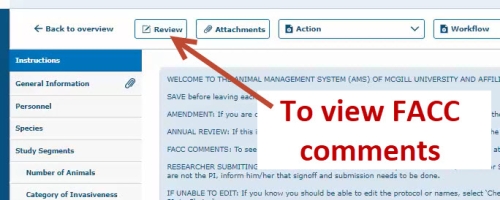
In the popup window, you can either click on each of the protocol tabs to see which comments were made for that section OR you can click the word 'All' at the top and this will list all the comments for the entire protocol. The words under 'Tab' relate to which protocol section/tab the comment is applicable. Note that if there is no popup, check to make sure it is not disabled in your computer/browser, there would be a warning at the top, is so, respond to it by asking to always allow popup for this web site.

Once a row from the list is clicked, there is a popup with the FACC comment. You either revise your protocol to clarify, supply the information or correct as recommended OR you can explain why you should not in the text box, click the 'Save' button and check the other comments by using the 'Back' button. Each row has a comment (or more if related to the same thing).

If you have a LOT of comments, you can ask your FACC Coordinator to send you the Excel file that she/he can produce by clicking 'All' then 'Generate Report' from her/his Review popup window. Note that we have asked the software vendor to make this option available to all users but they have to develop it. If you do not know who is your FACC Coordinator please check the FACC and Local Administrator list.
Make the changes into the protocol directly, using the protocol tabs to navigate through it.

Once all done, select the option 'Save and Check-In' from the 'Action' button at the top.

Click 'Close the window' of the Review popup and select 'FACC Administrative Review' from the 'Workflow' button at the top of the protocol window to submit back to the FACC.

And you're done. Once approved by the FACC, an automated email is generated and the status for the protocol becomes 'Approved'.
How to review a protocol or amendment if you are an FACC member
If you are a Facility Animal Care Committee (FACC) member, you will be assigned protocols and amendments to review via AMS. The FACC Coordinator is the one to select who are to review it. Once he/she submits to these members for review, an automated email is generated by AMS to alert you that something is pending your review. The email you will receive looks like this:

You could use the hyperlinked word 'here' of that email to get into the protocol directly (you may have to log into AMS before it opens) but we recommend another way to save you some steps at the end of your review:
1- Note the protocol number from the AMS automated email;
2- Log into AMS, click the 'AUP' button to get to the AUP main section;
3- Select the filter 'Waiting for my DM Review' (DM stands for Dedicated Member) then click the 'Apply filter' button:

4- Find the protocol number that needs your review. You can scroll through the list or use the 'CTRL' and 'F" keys to find it if it's a long list. Once you see it, click on the row of that protocol file. It will expand and show you the draft version pending your review.
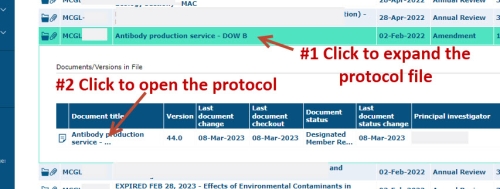
5- Click on that indented Document row to open the protocol. The first page will be the instruction page to the PI. DO *NOT* USE THE CHECK-OUT OPTION IN THE 'ACTION' BUTTON.
Note that once inside the protocol or amendment, you will see at the top of your screen: the protocol title, protocol number, version number, type of application (if Annual Review or Amendment or Initiated) and what level the application is at:

There are ONLY 3 things you are to use:
- The Review button to open the popup window where you type your comments - your browser may be blocking popup windows so if nothing appears when you click the Review button, check the top of your internet browser and see if there is a warning, if so, specify to always allow popup for this site;
- The 'Compare Version' option under the Workflow button to be able to see what was changed from the currently approved version (only use when it's an Annual Review or an amendment because full renewals and new protocols have no past approved versions);
- The Protocol tabs to navigate from one section to another. Usually, for amendments and Annual Reviews, you go to the sections highlighted with the changes but if it's a new protocol or full renewal, you need to click one protocol tab after another to review the entire application and it ends at the 'PI Certification' tab.

6- Please open both the 'Review' and the 'Compare Version' popups to help you with your review.
7- Clicking the Review button launches a popup window where it gives you the list of protocol tabs and a button called '+ Start New Topic'. If you have a comment to make, click the protocol tab where the comment belongs and then click the '+Start New Topic' button:
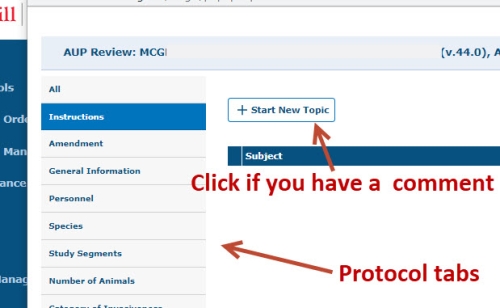
8- Once in the 2nd popup, you will notice that the name of the protocol tab that you had selected is automatically copied in the Topic subject line (you can add some text to this if you want). Type your comment in the big box and then click the '+ Publish' button and it will be saved and available for other members to see. You can click the 'Back' button to return or any of the protocol tab. The 'All' at the top of the list of protocol tab will show all the comments currently made.

9- Note that if it is an amendment, there will be an additional protocol tab called 'Amendment'. If it is an Annual Review, there will be another additional protocol tab called 'Annual Review'. Both will be at the top of the list of protocol tabs. It's important to see what the PI answered to those specific questions.
10- Note that if someone else already made the comment you wanted to make, please do not repeat the comment but please add to the previous comments if needed. You can delete (trashcan icon) or edit (pencil icon) your comments and see what others said.

11- To see what was changed by the PI, select the option 'Compare Version' under the 'Action' button at the top.

12- Once the 'Compare Version' is selected, you get a list of all the different versions that protocol has undergone. For the purpose of protocol review by the FACC, please select the last version that had a status of 'Approved'. Select the top most listed 'Approved' version and then click the 'OK' button.
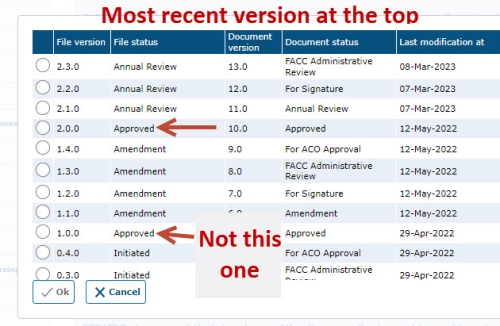
13- Once clicked, there will be a popup window. This will present you with the list protocol sections that had changes made. When you click on the protocol section, it will expand and show you the unchanged text in black, the deleted text in red strike-through and the new text in green. Note that the main protocol will show you the text in black as it would look like if you approved the changes. When finished with this popup, just click the 'Close Window' link at the top and once the popup is gone, you can click the 'Stop comparison' button at the top of the protocol but this is not mandatory.

14- Once all done, click the hyperlinked 'Back to overview' with the left arrow at the top left of the main protocol.

15- This will bring you to the AUP homepage and the protocol will still be highlighted in green and ready for you to confirm your review. Note the tiny post it page on the left of the protocol title (called Document Title). If you hover over it with your computer mouse, you will see the deadline for review and the list of committee members' initials. You need to confirm to the coordinator that you have reviewed this protocol/amendment (and this will show you that you did in case you're not sure). Mouse right-click that paper icon and select 'Edit Comment'.

16- Type 'Done' next to your initials then click the 'Save and close' button. You're done.

You're done!
How to compare different versions of the protocol
At any time, you can compare a current or pending protocol with a previous version. There is a new version every time the status of a protocol changes. The different statuses are: Initiated, For Signature, FACC Administrative Review, Designated Member Review, For PI Revision, for ACO approval, Approved.
To do the comparison:
1- Open the protocol (it doesn't matter if it is an approved version, a new protocol, an amendment or Annual Review in progress).
2- Then select the option 'Compare Version' under the button 'Action' at the top:
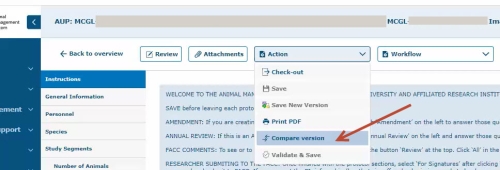
3- There will be a popup window (if this does not happen, please check your browser at the top, it may be blocking popups and if the case, choose to always allow popups for this site). In the popup window, you will see a list of the different versions for that protocol. You can select any version that you want. If you want to see the changes since the last approved version, find and check the radio button for the first occurrence of a status of 'Approved' from the top. Then click the 'OK' button.

4- The above popup will be replaced by a new popup which will list the protocol tabs that have differences between the 2 versions.

5- Click on each to expand and see the text. The changes are highlighted as such:
- Black text is for what is unchanged;
- Green text is what was added;
- Red strike-through text is what was deleted.

6- While in the Compare mode, the main protocol will show a yellow border around the protocol sections that had changes. The text you see is the final version if the pending amendment or renewal is approved.

7- You can also click the hyperlinked 'Details' word in the bottom of a protocol section that had changes (lined with a yellow border) and it will show the text with the changes highlighted.
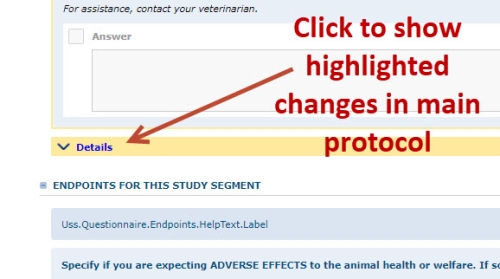
To get:
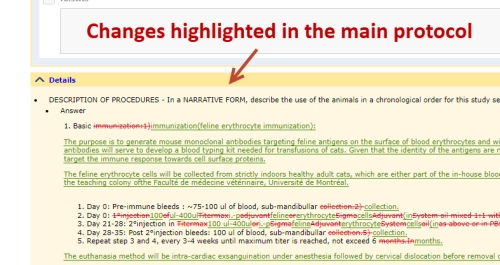
8- When finished, just click the 'Stop Comparison' button at the top.

Signing off to submit a protocol or amendment
There may be some confusion when it's time to sign off and submit a protocol or amendment.
- A status of 'For Signature' is waiting for the PI to sign off to submit (or for the FACC Chair to approve, the automated email notification will tell who it's waiting for);
- A status of 'FACC Administrative Review' means it was submitted to the FACC.
Please look at the Document Status, not the File Status:

The progression of a protocol is by going from one status to another.
A new protocol:
- Would start with a status of 'Initiated';
- The Principal Investigator (PI) or Protocol Editors type the answers or upload attachments within the protocol form;
- Once ready to submit, the PI or Protocol Editor will push it to the next status which is 'For Signature' by selecting this option under the 'Workflow' button at the top. In the popup window, selecting 'OK'. This action will push the protocol to wait for the PI to sign off - It did not submit yet;
- The PI must select the option 'Signatures' from the 'Workflow' button at the top. This will present a popup window for the PI to type his/her password and click the 'Sign' button - This will submit the protocol to the FACC;
- It was pushed to a new status of 'FACC Administrative Review'.
A protocol returned for revision:
- The protocol or amendment must have a status of 'For PI Revision';
- The Principal Investigator (PI) or Protocol Editors make the modifications and/or upload attachments within the protocol form;
- Once ready to submit, the PI or Protocol Editor will push it to the next status which is 'For Signature' by selecting this option under the 'Workflow' button at the top. In the popup window, selecting 'OK'. This action will push the protocol to wait for the PI to sign off - It did not submit yet;
- The PI must select the option 'Signatures' from the 'Workflow' button at the top. This will present a popup window for the PI to type his/her password and clicking the 'Sign' button - This will submit the protocol to the FACC;
- It was pushed to a new status of 'FACC Administrative Review'.
For new protocols or full renewals (duplicated from old expiring protocols), you will see that the protocol tab 'PI Certification' will have more information on the submission:

Note that for current or past protocols, if the box in the bottom was clicked, it will retain the old version of the text to preserve the integrity of the answer to the question.
Always check immediately to see if the status is at 'FACC Administrative Review' to make sure it was submitted.